If your food shots do little more than just show food in a very literal and straightforward way, you’re missing out on a big part of what makes food photography so powerful: narrative. In this post I want to consider ways in which we can use visual storytelling techniques to create compelling photographic narratives about food.
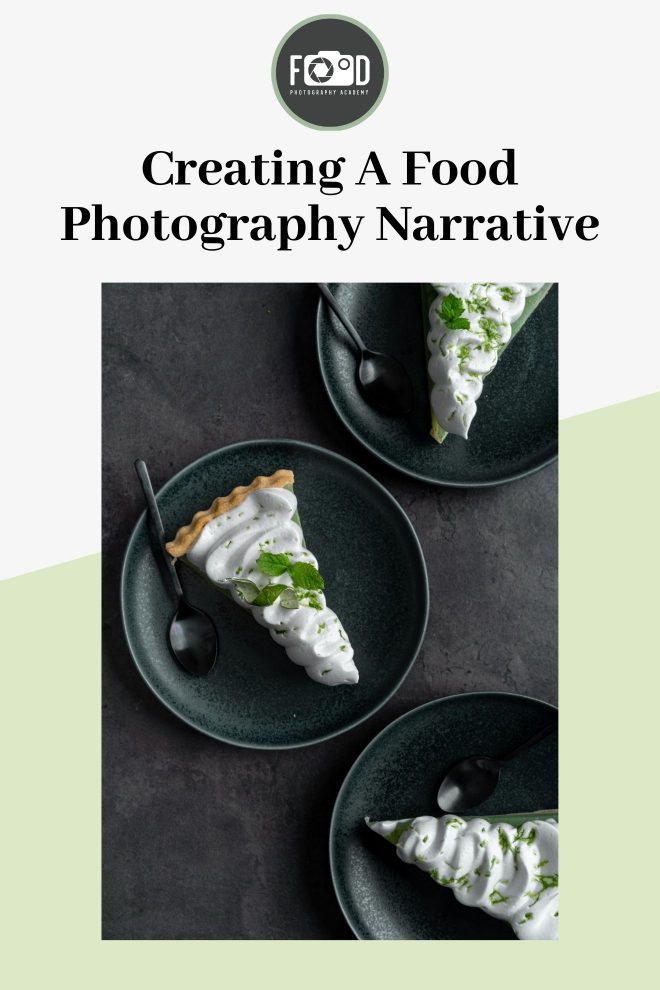
What Is a Food Photography Narrative?
A photographic narrative is just a fancy way of saying storytelling with photography. When you look at Cindy Sherman’s Untitled Film Stills, or the work of a photographer like Gregory Crewdson, it’s obvious what we mean by photographic storytelling. Although these photos are often quite ambiguous, they depict scenes which suggest all kinds of possible stories. But these are photos featuring actors. And, in the case of Crewdson’s work, usually shot on elaborate sets like a movie. That’s all very well, but what kinds of stories can we tell about food?
When we speak of a narrative in food photography, we mean creating a photo – or most often a series of photos – that does much more than simply show a dish or product in a literal way. Sure, there may not be quite the same scope for storytelling with food photography as there is with, say, fashion or portrait photography, but don’t underestimate just how important storytelling is to good food photography. Creating a narrative with food photography is about using props, angles, lighting, location – in fact all the photographic tools and tricks at your disposal – to create an atmosphere that suggests intriguing and appealing stories in the mind of the viewer. Stories that enhance the appeal of your subject.
Why Is Narrative Important in Food Photography?
Think about high-end fashion photography. Fashion advertising is often less about showing the actual clothing than about creating an aspirational image for the brand – for example, by shooting beautiful models in luxurious locations. In food photography we generally want to see the food, but there’s a lot more to making a dish appear desirable than just shooting it in a flattering light. Just as people will purchase a certain fashion item because it makes them feel transported to another time and place, or because they imagine that it turns them into a more glamorous or exotic version of themselves, food will be more appealing to us if we associate it with a certain atmosphere or image. This is where photographic storytelling comes in.
Narrative in Series
Narrative is particularly important when shooting a series of images. This is for two apparently contradictory reasons: variation and continuity. Firstly, by aiming to create a narrative, you are more likely to produce a series of photos that is varied and diverse – rather than repetitive and boring. If a magazine commissions you to shoot a set of photographs that will run across several pages, they will probably not be happy if you deliver what are essentially just several subtle variations of the same shot. Shooting a series of dishes in an identical and formulaic style (same background, identical lighting, and angle etc.) is a totally valid creative choice in many situations. But unless an editorial client has specifically asked for it, it’s unlikely that this is what they’ll be expecting from you. Instead they will want to see variety. A comprehensive and varied series of images is more likely to retain the viewer’s attention. However, it’s equally important that these images hold together as a unified body of work. Just imagine if you sat down to watch a movie and discovered that each scene was shot by a totally different director in a totally different style: jumping from rough, handheld action-footage one minute, to slick and stylized scenes the next. Confusing. Creating a photographic narrative will help to establish a stylistic thread running through all the images in the series, uniting them as a single piece of work.
Related: Bring Your Food Photography To Life With These Creative Composition Techniques
Shooting a Single-Story Narrative
Food photography that is more directed towards the editorial and lifestyle sectors of the market tends to make a lot of use of photographic storytelling. But narrative techniques can just as equally be applied to shooting a series for other areas of food photography too. Even something as simple as a restaurant menu may benefit from a little photographic storytelling in order to pique interest and stimulate the appetite.
But what does a food photography narrative look like? To be honest, the only real limit here is your imagination. But as a generalization, we could say that storytelling within food photography is often about expanding the range of focus to show much more than just the hero dish. To use a cinema metaphor again, a movie consisting of a single uncut scene, shot from the same static point of view, and featuring the same actors in the same location for 90 minutes would likely be unbearably boring. Instead cinematic storytellers employ a variety of shots – long, mid, close-up, cutaway, detail, establishing, POV etc. – to draw viewers into the narrative, making them feel like they are actually there. It’s the same with food photography.
For example, I recently shot a series of photographs around the theme of tomato dishes. These images were intended to be viewed as a single spread, so they needed to sit together stylistically. Yet I also wanted them to offer some variety so as not to risk boring the viewer. By shooting close ups and wider shots, switching the angles, and also including shots of side dishes alongside the hero, there was sufficient variety for the images to stand up as a series.
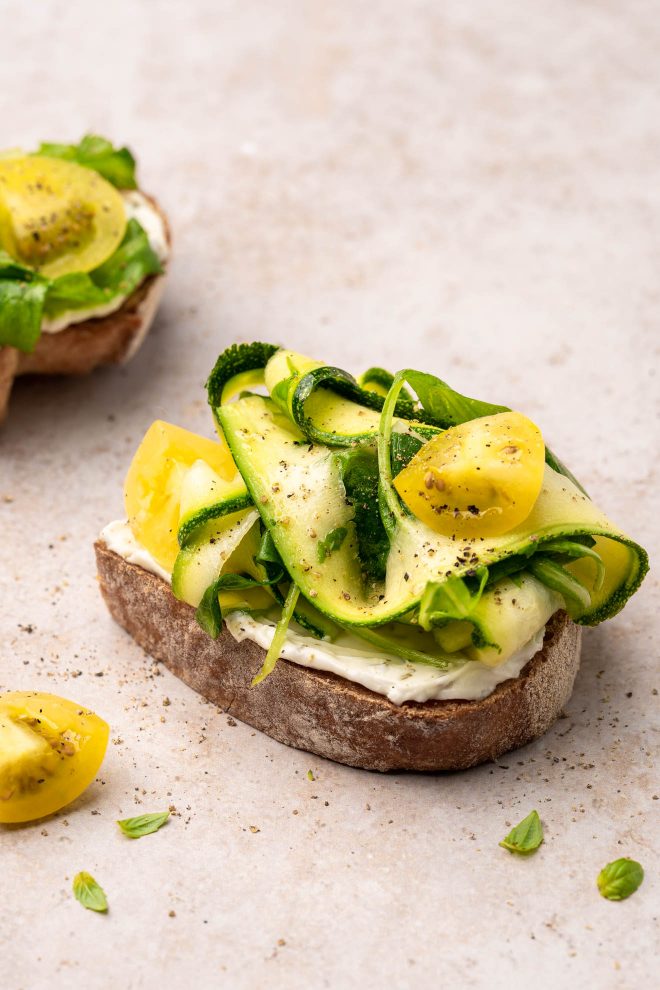
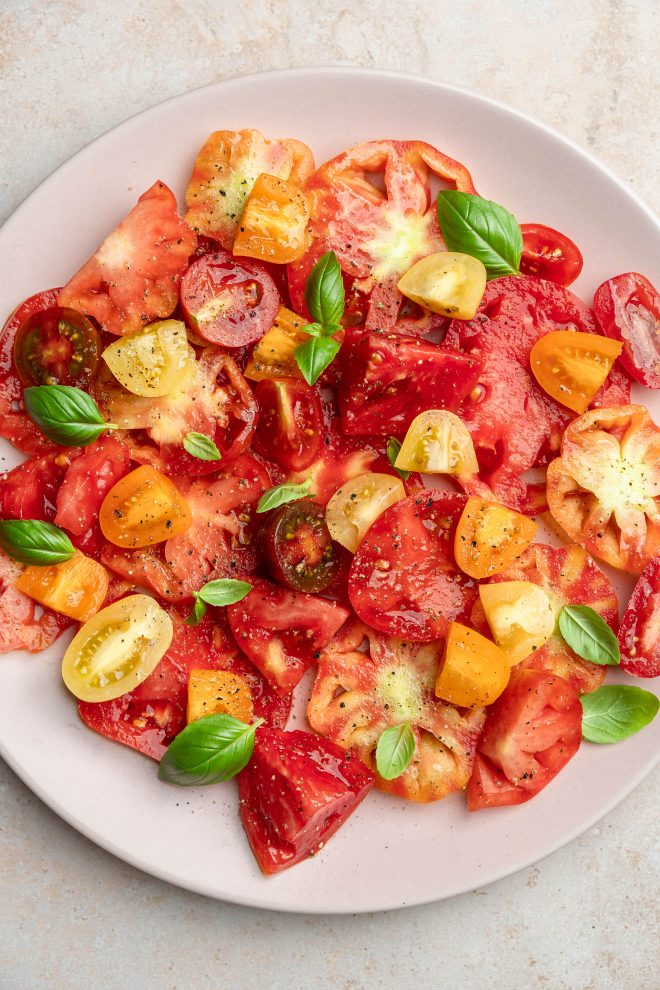
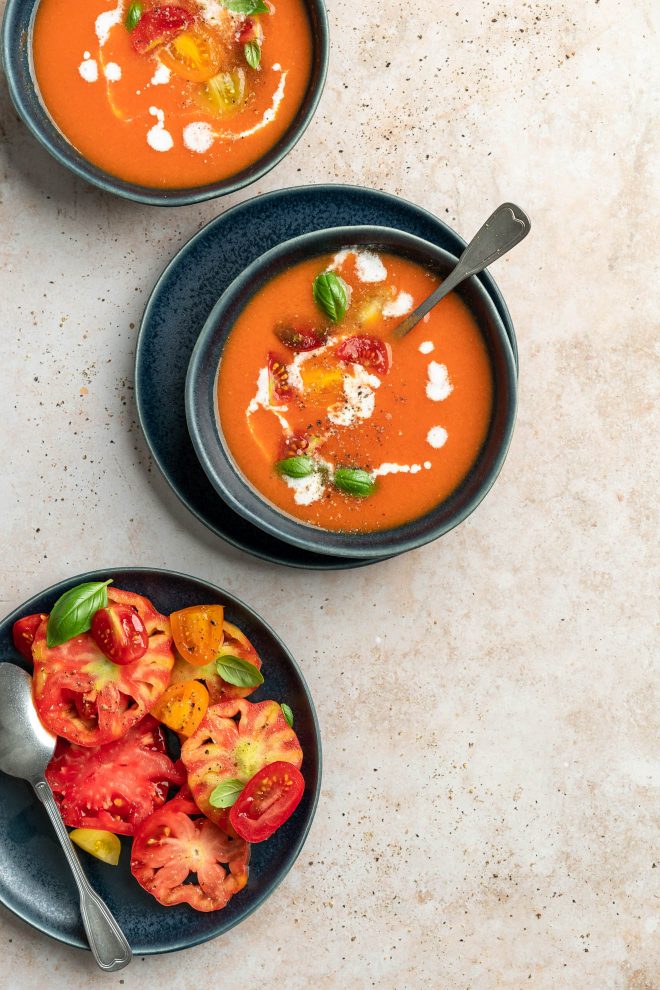
There are a whole load of other tricks I could have used here too though. If I was shooting in a restaurant, then a couple of shots of the interior would also have worked well. And what about a portrait of the chef? Perhaps while prepping ingredients? This underlines the fact that, in order to become an excellent food photographer, you really just need to be an excellent all-round photographer.
Photographic storytelling is about creating a vibe, an atmosphere that makes people want to eat. Or to cook. Once you break away from ingrained food photography habits – such as simply prepping and shooting a hero dish under lights and then calling it a wrap – there’s so much that can be done with a food photography narrative. Nothing makes me want to eat in a certain restaurant more than the feeling that there’s a really passionate, fun, and communal vibe going on there. So if I see shots of enthusiastic staff working together to create amazing food, I’m usually sold. But you needn’t be in an actual kitchen in order to inject a little documentary-style energy into a photograph: asking a friend or your assistant to stand in so that you’ve got out-of-focus body parts in the foreground to shoot through can help to suggest a much more lively scenario than just another sterile studio set-up. For a great example of the potential of food photography to create a lively and compelling narrative over an extensive series of images, check out Peden + Munk’s Sun Surf & Sumac.
Food Photography Narrative Ideas
In order to help you improve your photographic storytelling skills, here are some of the main points you may want to consider when developing a photographic narrative.
Research and Development
How you plan a shoot can make a big difference to its narrative effect. Although sometimes it can be enough merely to have a vague image or atmosphere in mind before going into the studio, it can often be helpful to put together a moodboard long before shoot day. And if you really want to be sure of creating a varied and captivating narrative, consider storyboarding some of your shots in advance.
Ingredients
Something as simple as a single ingredient carried across several dishes can be all it takes to give a strong unifying thread to a photographic narrative. Take a mint-themed shoot for example: dishes could vary from salads and pasta, to drinks and dessert, yet they’d all be held together by the consistent theme of the mint.
Angle and Framing
A dish can vary massively in appearance when shot from radically different points of view. But for food photographers looking to create a photographic narrative, angle and framing offer a great deal more than merely allowing you to visually switch things up. What is included, and excluded, from the frame will significantly alter the viewer’s understanding of any photograph. Consider whether there might be other ways of framing a dish or subject that better communicate the story you want to tell.
For example, if you were shooting in a restaurant where the atmosphere is very calm; the decor minimalist; the service polite; and the food meticulously prepared and presented; the best way to communicate this story might be by producing images with very simple and squared-off framing, leaving lots of empty space around the subject. On the contrary, in the case of a restaurant that is primarily appealing because of its raucous and fun-filled atmosphere – with diners eating together at communal tables – this vibe would probably be more effectively represented by the use of cluttered and energetic framing.
Remember though, in order to serve as inspiration for a successful narrative shoot, neither of these hypothetical restaurants need exist anywhere but on a moodboard (see Research and Development above). Even if you are working on a studio shoot featuring just a handful of dishes and little else, imaging that the shoot is taking place in a location such as the ones just described can help to dictate your framing – and indeed every other creative decision too.
Props
Clearly props play a super important role in photographic storytelling. Are you going for a wholesome and natural look? Or perhaps one that’s more about faded decadence and self-indulgence? The props you choose will go a long way towards determining the impression viewers take away from a series of images.
Also, when used in conjunction with some of the other storytelling techniques we look at here, a prop can be used to create continuity between two different shots – by using it twice, to link the two. Or instead you can help differentiate a shot from any similar ones by using a totally unique prop.
Colour
Decisions about colour are central to the creation of any photographic narrative. By sticking to a limited chromatic theme across a series, you can help to unify what otherwise might be a quite diverse group of images. For example, with this series of photos of a lime dessert, I made the decision to restrict the colour palette largely to black, white, and lime green: creating a distinctive visual identity that helps the images to sit together as a unified whole.
Another reason why colour is such an important storytelling tool is that it immediately suggests a certain mood. For example, a tropical-themed shoot needn’t feature any exotic locations, props, or ingredients at all beyond the hero dish, and yet may still very successfully conjure up a strong vibe of sandy beaches, shady palms, and azure waters. All of this could be achieved from the comfort of your studio just through the suggestive use of bold coloured backdrops. In this lime series, I pulled together the idea of a lime theme, plus kept to an analogous colour scheme (focusing on green and blue tones) to create this lime series.
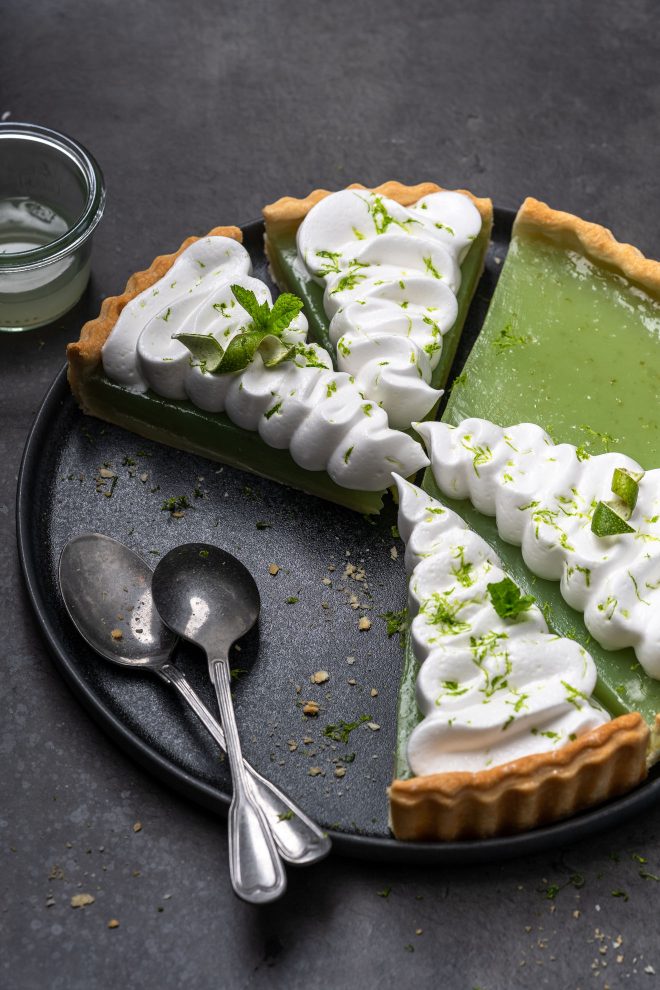

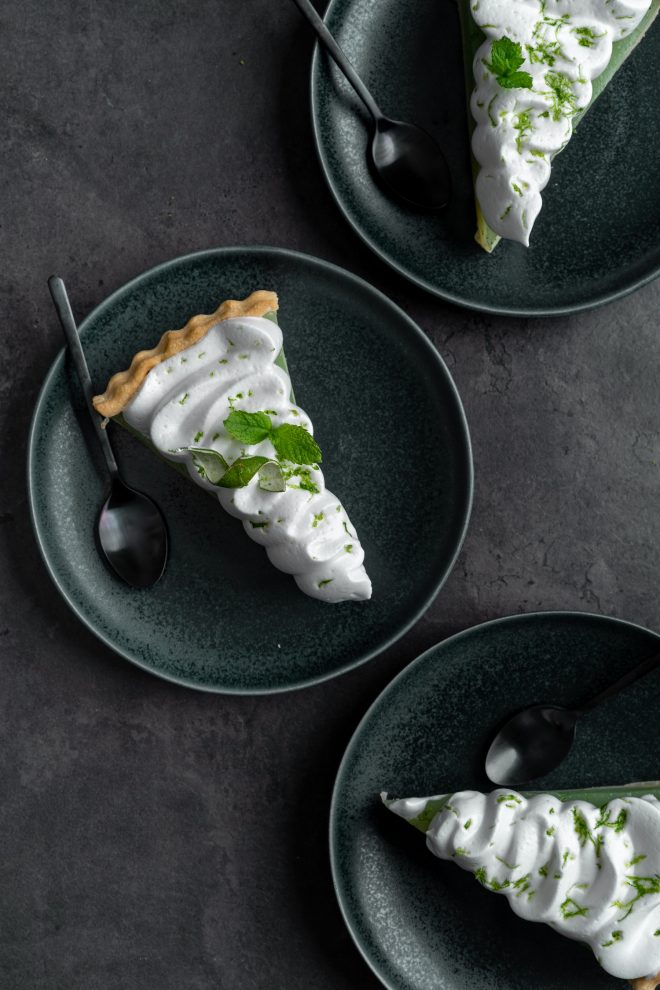
Lighting
Carefully consider your lighting. Not only will a distinctive lighting style help to create consistency across a series of images, but the kind of lighting you go for will massively alter the story these images communicate to viewers. For example, if you shoot a dish under the harsh midday glare of the tropics, it’s going to tell a totally different story than if you went for the cool diffused light of a north-facing window. Don’t choose a certain kind of lighting for your shoot simply because it looks good though: lighting should always make sense within the narrative you’re trying to create.
Editing and Sequencing
Even once you’ve shot a set of images and finished postproduction, there’s still a lot that you can do to help the series work better as a cohesive story. Unfortunately though, in the age of constant over-sharing, tight and effective editing of a photographic narrative is becoming something of an endangered skill. Often you’ll see photographers who have clearly struggled to whittle down a shortlist of similar – looking photos into a single definitive choice. Their solution? Just use them all. This is a mistake. Sure, it’s quite common to come out of a shoot with several equally good, yet only very subtly different, images of the same subject. And admittedly it’s never fun to have to reject images that you really like. But reject them you must, because by including more than one version of what is effectively the same shot in your final selection, all you are doing is watering down the impact the series will have on viewers. Be ruthless, confident, and decisive in your edit. At the very worst, you could always switch an image or two out if you
change your mind later when it comes to showing the work in your portfolio. But don’t just include all of them due to an inability to decide.
It’s not only about what you do and don’t include in a narrative series that matters though: equally important is how you include it. The sequencing and pacing of images can make an enormous difference to the final impression a photographic series has on the viewer. Every photographer has their own preferences and methods, but generally you’ll find that it works best to pace out similar shots, rather than grouping them all together; break up the monotony with a few stylistically different images in between.
When sequencing, some photographers like to look for a visual link between adjacent images; others create a more literal narrative in their heads, imagining a story unfolding from one image to the next. While others just choose the order of images more intuitively. All are valid techniques. What matters is that you think about the sequencing carefully and find a method that works for you.
Narrative Across a Portfolio
One area that’s often overlooked is the use of narrative techniques when putting together a portfolio. Just because most of the images in your portfolio were shot at totally different times and places, and for different purposes, doesn’t mean that they shouldn’t work together to create a cohesive narrative. Whether we’re talking about an online portfolio, a digital presentation, or a physical book of prints, many of the same storytelling principles we’ve looked at above still apply.Just as with an individual narrative photographic series, a portfolio needs to hold together in terms of both story and style. Stylistically, you want to leave viewers in no doubt as to what it is that you do. Story-wise, the narrative shifts away from being about the subject of the individual photographs, instead becoming a story about you, the photographer. Look upon your portfolio as a short movie, with yourself in the lead role. This is your opportunity to tell clients who you are as a photographer. And like any good story, your portfolio should have a dramatic beginning to grab the viewer’s attention; a strong middle to keep their interest, and then an action-packed ending that leaves them awestruck. And just as we mentioned earlier, all of this needs to be presented in a stylistically-unified and convincing manner, or you’ll risk confusing people. In practice this will likely mean excluding certain images – ones that you may be very proud of if they don’t fit with the overall narrative of your portfolio.
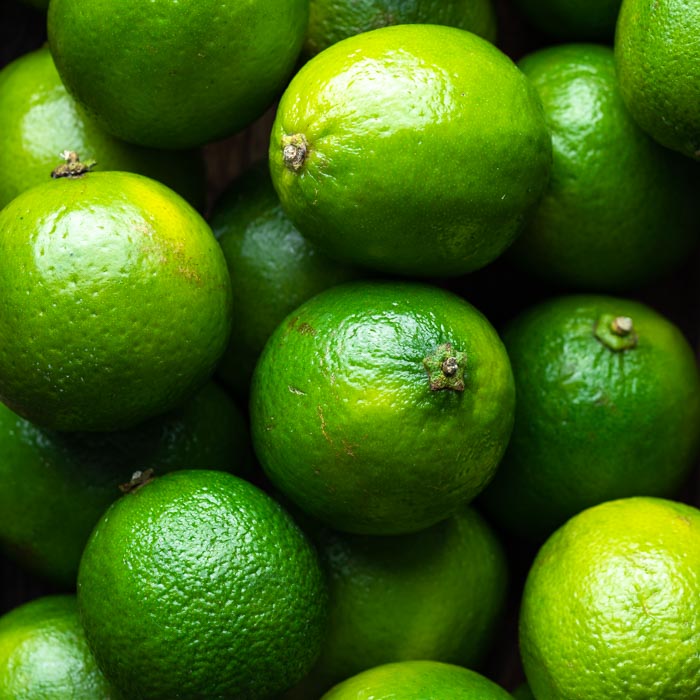
This is so helpful, thanks so much. Your printed portfolios are gorgeous !!
Thank you so much Lauren! It takes a lot to prepare a cohesive look and narrative for a bigger project BUT it is totally wortj it at the end! I would love love love to see and actual example of your planning process before a bigger project. Maybe also on a Youtube 🙂
Very helpful! Thank you.
So well written and comprehensive. Thanks for putting the time and effort into this informative post! I learned a lot and will now be considering many factors before starting a shoot 🙂
So glad this was helpful Patty!